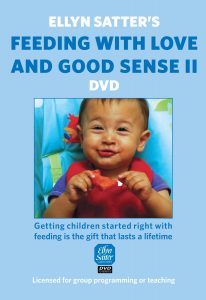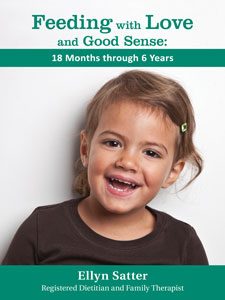

Family Meals Focus
The Ellyn Satter Institute Newsletter
Review, The Two Bite Club
by Ellyn Satter, Registered Dietitian and Family Therapist
It is gratifying when nutrition professionals take the big step to writing educational materials from a feeding dynamics point of view. However, since the conventional approach to nutrition education is controlling and paternalistic, it is isn’t surprising when controlling messages creep in to presumably feeding friendly messages. With that in mind, let’s examine the controlling messages in The Two Bite Club, a free (and therefore widely distributed) publication of USDA’s Food and Nutrition Service:
Will shares the school lesson: eat two bites
Older brother Will is the protagonist of the piece. “My teacher said that if we eat two bites from each food group we can be members of the Two Bite Club!” Will’s teacher is to be forgiven for this – most teachers don’t know about the division of responsibility in feeding. Teachers interested in nutrition can be a bit zealous – and controlling – in their efforts to get children to eat the “right” food.
Anna knows she is being manipulated
The Two Bite Club is faithful to the reality of feeding children: most parents pressure their children to eat, and only reluctantly take no for an answer.
Little sister Anna can smell pressure a mile away. “OK, but I might not like it,” she replies cautiously. Mother says, “Anna, I know you can be a big girl and try two little bites of each food, then you will be in the Two Bite Club!” Sure enough, Anna’s caution is well-founded. There are not just one but two cleverly disguised pieces of pressure in one sentence: 1) If you force yourself to eat you will be a big girl and 2) It is only two little bites. Anna is only a preschooler, and she isn’t able to deconstruct that sentence. However, like most children, she knows what she knows – she is being railroaded! So far, the Two Bite Club is faithful to the reality of feeding children: most parents pressure their children to eat, and only reluctantly take no for an answer.
LIttle games still put on pressure
First, they play a little game. They find a food that fits in the grain group of MyPyramid for Preschoolers. Well, all right, that’s kind of like a treasure hunt. Anna likes treasure hunts. Will finds some whole-wheat crackers. “Let’s try these!” he says. “Oh, no,” says Anna, “I don’t think I’ll like them.” Anna can smell pressure, even when it is coming from Will! Anna might be one of those slow-to-warm-up types, but more likely she is just a typically canny preschooler. Here is where our book takes leave of reality. “But she [Anna] tried two little bites. ‘I like them!’” she exclaimed.
Pressured children resist trying new food
Oh, come on. How realistic is that? Every child I have seen coerced this way makes a sour face and says “Eew! I don’t like it!” The research says the same. When you coerce children to eat, they like foods less well, not better. Even when you don’t coerce them, it takes a lot of exposures – 5 or 10 or 47 – for a child to learn to like a new food. The slow-to-warm-up types take longer. Anna might be a slow-to-warm-up type, or she might just be made to appear that way by the hard sell for this strange club.
Pressured children have bad food manners
So on they go. Like the bread group, the perfectly acceptable treasure hunt for vegetables contains a zinger: Anna has to take two bites of broccoli. So what if they are only little tiny microscopic bites? What if Anna only has to lick it? Do you know how gross it is to be strong-armed into making close contact with something – strange? Here is a more likely scenario: Anna took a bite of broccoli. “Eew! I don’t like it!” she gagged, spitting it on the floor. (We could have her spitting on her plate or in her napkin but Anna, Will, and Mother are all standing up for the Club meeting.)
Picking out food doesn’t make children eat
Then they hunt for fruit. By now, you would expect Anna to slope off to watch Dora the Explorer rather than play this game, but our story has her coming back for more. This time, Anna gets to choose, and she finds a yellow apple in the fruit bowl. The optimistic folks who hope that letting Anna pick the food will get her to eat it are heartened. Ever vigilant, Anna recognizes the pressure. “I don’t think I like yellow apples; I only like red apples,” she says.
Anna’s mother says, “you don’t have to eat it if you don’t want to”
So let’s give Anna a break and write a new ending to our story. “You don’t have to eat it if you don’t want to,” says mother, learning from her mistakes. “Yes,” says Will. “Let’s forget about the bites. I don’t have to belong to any dumb club in order to enjoy my food.”
Will and Anna pick and choose from what Mother makes available
So Mother got Will and Anna’s lunch ready. She put on the whole grain crackers and broccoli and stirred some Ranch Dressing mix into the yogurt to make dip. She put on some cheese and some milk and they all agreed those foods were from the milk group. She peeled the apple and cut it up. Anna could see that, inside, the yellow apple was just the same as a red one. Mother let Anna and Will pick and choose what to eat from what was on the table. Anna ate a whole apple and some cheese and drank some milk and dipped a cracker in the dip and ate a little corner of it. She ignored the broccoli – she’d had enough of that for one day.
And they all ate happily ever after.
Explore
To raise your child to happily join in with your family meals and learn to eat the food you eat, read Ellyn Satter’s Feeding with Love and Good Sense: 18 Months through 6 Years. Reading about what to do, how to do it, and stories from other parents reassures you that you are on the right track.
To see how children really behave with eating as well as to read about it, see Ellyn Satter’s Feeding with Love and Good Sense DVD II. For home use version, click here.

Related issues of Family Meals Focus
- Food restriction in disguise
- Should you control portion sizes?
- Should you put your child on skim milk?
- Sticky topic of Halloween candy
- Vegetable agenda: Getting children to eat “nutritious” food
- Managing “junk” food AKA sweet, chips, sodas
- Trouble-shooting with the division of responsibility
- Moves and counter-moves with feeding your child

